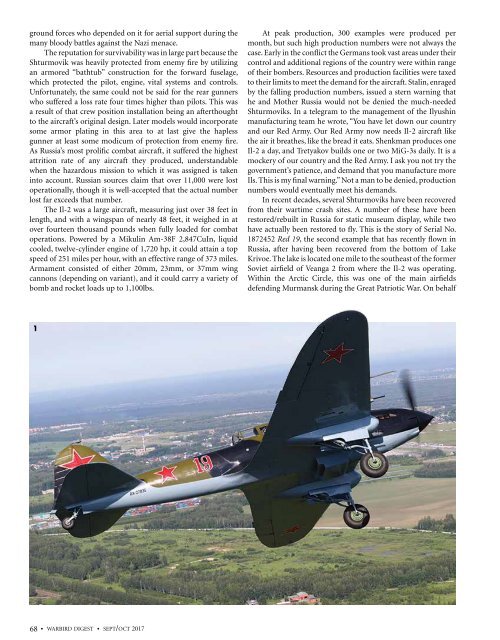WD74W2
Create successful ePaper yourself
Turn your PDF publications into a flip-book with our unique Google optimized e-Paper software.
ground forces who depended on it for aerial support during the<br />
many bloody battles against the Nazi menace.<br />
The reputation for survivability was in large part because the<br />
Shturmovik was heavily protected from enemy fire by utilizing<br />
an armored “bathtub” construction for the forward fuselage,<br />
which protected the pilot, engine, vital systems and controls.<br />
Unfortunately, the same could not be said for the rear gunners<br />
who suffered a loss rate four times higher than pilots. This was<br />
a result of that crew position installation being an afterthought<br />
to the aircraft’s original design. Later models would incorporate<br />
some armor plating in this area to at last give the hapless<br />
gunner at least some modicum of protection from enemy fire.<br />
As Russia’s most prolific combat aircraft, it suffered the highest<br />
attrition rate of any aircraft they produced, understandable<br />
when the hazardous mission to which it was assigned is taken<br />
into account. Russian sources claim that over 11,000 were lost<br />
operationally, though it is well-accepted that the actual number<br />
lost far exceeds that number.<br />
The Il-2 was a large aircraft, measuring just over 38 feet in<br />
length, and with a wingspan of nearly 48 feet, it weighed in at<br />
over fourteen thousand pounds when fully loaded for combat<br />
operations. Powered by a Mikulin Am-38F 2,847CuIn, liquid<br />
cooled, twelve-cylinder engine of 1,720 hp, it could attain a top<br />
speed of 251 miles per hour, with an effective range of 373 miles.<br />
Armament consisted of either 20mm, 23mm, or 37mm wing<br />
cannons (depending on variant), and it could carry a variety of<br />
bomb and rocket loads up to 1,100lbs.<br />
At peak production, 300 examples were produced per<br />
month, but such high production numbers were not always the<br />
case. Early in the conflict the Germans took vast areas under their<br />
control and additional regions of the country were within range<br />
of their bombers. Resources and production facilities were taxed<br />
to their limits to meet the demand for the aircraft. Stalin, enraged<br />
by the falling production numbers, issued a stern warning that<br />
he and Mother Russia would not be denied the much-needed<br />
Shturmoviks. In a telegram to the management of the Ilyushin<br />
manufacturing team he wrote, “You have let down our country<br />
and our Red Army. Our Red Army now needs Il-2 aircraft like<br />
the air it breathes, like the bread it eats. Shenkman produces one<br />
Il-2 a day, and Tretyakov builds one or two MiG-3s daily. It is a<br />
mockery of our country and the Red Army. I ask you not try the<br />
government’s patience, and demand that you manufacture more<br />
Ils. This is my final warning.” Not a man to be denied, production<br />
numbers would eventually meet his demands.<br />
In recent decades, several Shturmoviks have been recovered<br />
from their wartime crash sites. A number of these have been<br />
restored/rebuilt in Russia for static museum display, while two<br />
have actually been restored to fly. This is the story of Serial No.<br />
1872452 Red 19, the second example that has recently flown in<br />
Russia, after having been recovered from the bottom of Lake<br />
Krivoe. The lake is located one mile to the southeast of the former<br />
Soviet airfield of Veanga 2 from where the Il-2 was operating.<br />
Within the Arctic Circle, this was one of the main airfields<br />
defending Murmansk during the Great Patriotic War. On behalf<br />
1<br />
68 • warbird digest • sept/oct 2017


